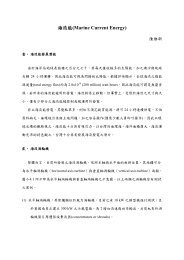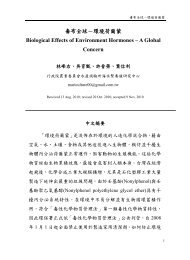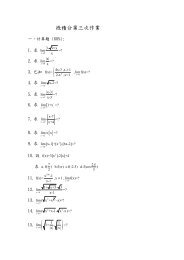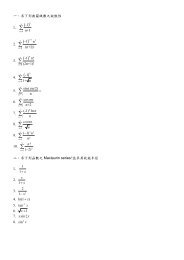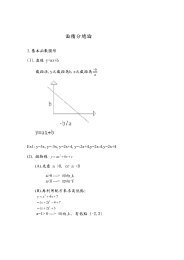Babel, a multilingual package for use with LATEX's ... - linsrv.net
Babel, a multilingual package for use with LATEX's ... - linsrv.net
Babel, a multilingual package for use with LATEX's ... - linsrv.net
You also want an ePaper? Increase the reach of your titles
YUMPU automatically turns print PDFs into web optimized ePapers that Google loves.
stringprocess Instead of a parameter, you can manipulate the macro<br />
\<strong>Babel</strong>String containing the string to be defined <strong>with</strong> \SetString. For<br />
example, to <strong>use</strong> an expanded version of the string in the definition, write:<br />
\Add<strong>Babel</strong>Hook{myhook}{stringprocess}{%<br />
\protected@edef\<strong>Babel</strong>String{\<strong>Babel</strong>String}}<br />
Four events are <strong>use</strong>d in hyphen.cfg, which are handled in a quite different way <strong>for</strong><br />
efficiency reasons – unlike the precedent ones, they only have a single hook and<br />
replace a default definition.<br />
everylanguage (language) Executed be<strong>for</strong>e patterns are loaded.<br />
loadkernel (file) By default loads switch.def. It can be <strong>use</strong>d to load a different<br />
version of this files or to load nothing.<br />
loadpatterns (patterns file) Loads the patterns file. Used by luababel.def.<br />
loadexceptions (exceptions file) Loads the exceptions file. Used by<br />
luababel.def.<br />
\<strong>Babel</strong>ContentsFiles<br />
New 3.9 This macro contains a list of “toc” types which require a command to<br />
switch the language. Its default value is toc,lof,lot, but you may redefine it <strong>with</strong><br />
\renewcommand (it’s up to you to make sure no toc type is duplicated).<br />
1.8 Hyphenation tools<br />
\babelhyphen<br />
\babelhyphen<br />
* {〈type〉}<br />
* {〈text〉}<br />
New 3.9 It is customary to classify hyphens in two types: (1) explicit or hard<br />
hyphens, which in T E X are entered as -, and (2) optional or soft hyphens, which<br />
are entered as \-. Strictly, a soft hyphen is not a hyphen, but just a breaking<br />
oportunity or, in T E X terms, a “discretionary”; a hard hyphen is a hyphen <strong>with</strong> a<br />
breaking oportunity after it. A further type is a non-breaking hyphen, a hyphen<br />
<strong>with</strong>out a breaking oportunity.<br />
In T E X, - and \- <strong>for</strong>bid further breaking oportunities in the word. This is the<br />
desired behaviour very often, but not always, and there<strong>for</strong>e many languages<br />
provide shorthands <strong>for</strong> these cases. Un<strong>for</strong>tunately, this has not been done<br />
consistently: <strong>for</strong> example, in Dutch, Portugese, Catalan or Danish, "- is a hard<br />
hyphen, while in German, Spanish, Norwegian, Slovak or Russian, it is a soft<br />
hyphen. Furthermore, some of them even redefine \-, so that you cannot insert a<br />
soft hyphen <strong>with</strong>out breaking oportunities in the rest of the word.<br />
There<strong>for</strong>e, some macros are provide <strong>with</strong> a set of basic “hyphens” which can be<br />
<strong>use</strong>d by themselves, to define a <strong>use</strong>r shorthand, or even in language files.<br />
• \babelhyphen{soft} and \babelhyphen{hard} are self explanatory.<br />
• \babelhyphen{repeat} inserts a hard hyphen which is repeated at the<br />
beginning of the next line, as done in languages like Polish, Portugese and<br />
Spanish.<br />
• \babelhyphen{nobreak} inserts a hard hyphen <strong>with</strong>out a break after it (even<br />
if a space follows).<br />
• \babelhyphen{empty} inserts a break oportunity <strong>with</strong>out a hyphen at all.<br />
13





